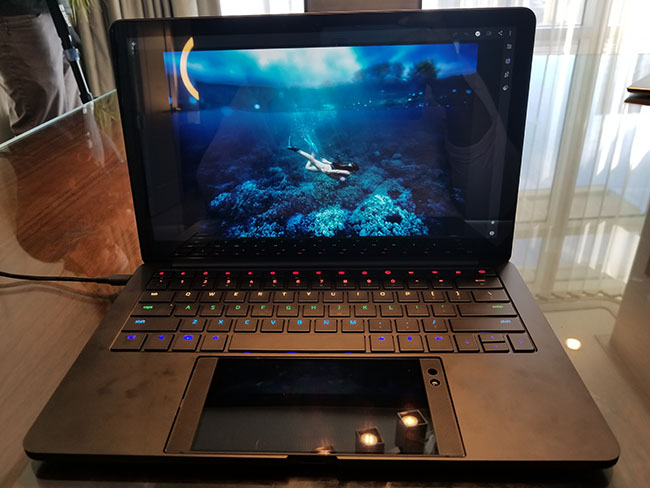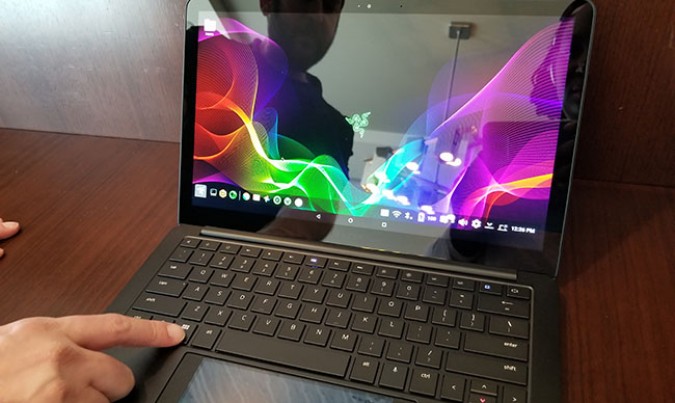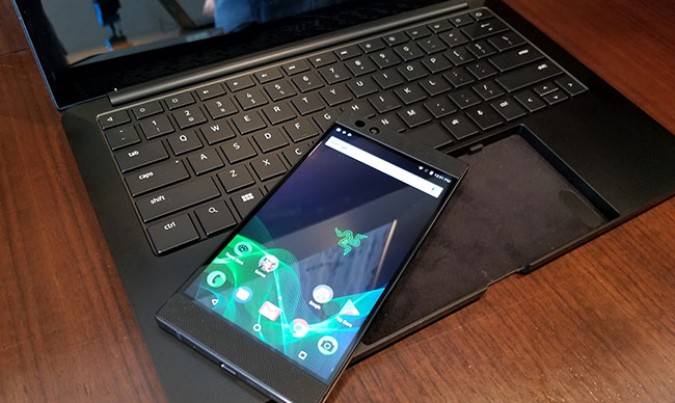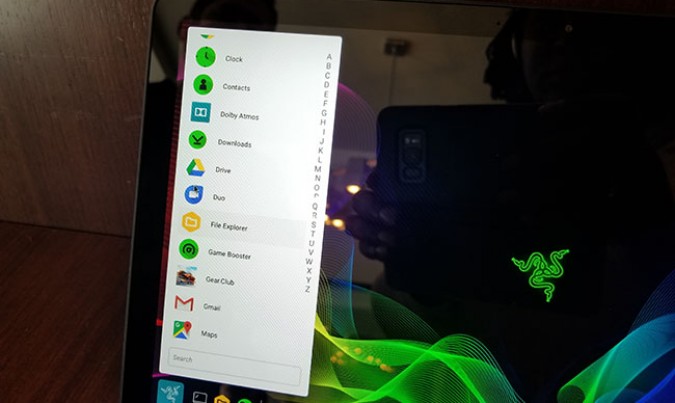Razer Project Linda Seeks to Reinvent the Lapdock
LAS VEGAS - After more than 10 years of attending CES, I can tell you that it's just not a show without Razer showing off some fantastical concept. In past years its been Fiona, Christine, and Valerie, but in 2018, it's time for Project Linda to step into the spotlight. A clever take on the lapdock, Linda essentially uses the Razer Phone, the company's first smartphone to power an ultraportable laptop. And believe it or not, they make a pretty convincing argument.
Fraternal Design
At first glance, you wouldn't be able to tell Linda apart from the Razer Blade Stealth. Both systems are made from that inky black CNC aluminum and have nearly identical dimensions with the former being approximately 0.5 inches thicker than the latter (12.6 x 8.1 x 0.5 inches). With the Razer Phone attached, Project Linda weighs slightly under 3 pounds, putting it on a par with the Stealth. However, since this is a concept, the final weight and dimensions are subject to change.

Open Project Linda's lid and you'll get more black aluminum along with Razer's trademark Chroma keyboard. But where you'd normally see a touchpad sits a depression, lined with a plush black fabric, waiting for the 6.2 x 3.1 x 0.3-inch Razer Phone to be inserted. When the smartphone is placed inside, it acts as a touchpad, audio source and second display reminiscent of the Switchblade UI found in the original Razer Blade Pro.
As far as ports, you'll find a USB Type-C port on the left alongside a headphone jack, a feature noticeably missing from the Razer Phone. Along the right sits a USB 3.0 port. The company hopes to add a display out port so owners can connect the system to a television or projector for an even bigger screen.
MORE: Which Razer Laptop Is Right for You? Blade vs Stealth vs Pro
Display
Unlike the Stealth, which sports a QHD (3200 x 1800) screen, Project Linda is currently making due with a FHD (1920 x 1080) panel. Ideally, Razer would equip Linda with a 2560 x 1440 Sharp IGZO panel similar to what's found on the Razer Phone. However, according to Razer, such a panel doesn't exist for the 13.3-inch size point.

Despite the lack of a super high-resolution panel, Project Linda didn't disappoint when it came to color and sharpness. Scrolling through several sample photos in Adobe Lightroom, I saw rich color and fine details like individual brown hairs cascading from the model's hair as she floated underwater in a cerulean backdrop.
Stay in the know with Laptop Mag
Get our in-depth reviews, helpful tips, great deals, and the biggest news stories delivered to your inbox.
Keyboard
Project Linda borrows some of the Stealth's best qualities like the improved keyboard. Despite the Stealth's 1.2 millimeter key travel, the keyboard never bottomed out during our testing. In fact, it had quite a bit of pop thanks to the 69 grams of actuation force needed to depress the keys. And while I didn't have the proper instruments to measure the keyboard, the brightly-lit keys seemed to have the same springy response.
Similar to other Razer laptops, Project Linda makes use of the company's spellbinding Chroma lighting. The laptop even has an app to configure the lighting. It's not as comprehensive as Razer's Synapse software, but it'll get the job done.
Speaking of the keys, in order to accommodate the Android operating system, Razer made some modifications. For example instead of the full row of function keys, three of them are designated as Back, Home and Recent Apps keys, similar to what you would find on an Android device. There's keys for Voice Search, Screen Capture and Docking and for you Windows users, you get a Start key next to the Search key. The Backspace key was a casualty of all these new additions, so in order to erase a mistake, you'll have to hit the Shift key in conjunction with the Backslash key.
MORE: Best Gaming Laptops (Including VR-Ready Gaming Laptops)
The Brains of the Operation
But what's a dock without power? In Project Linda's case, it's a paperweight -- a stylish one, but a paperweight nonetheless. The dock needs the Razer Phone and its Qualcomm Snapdragon 835 processor to make the magic happen. The powerful component, which is found in a number of high-end flagship smartphones including the Samsung Galaxy S8+ and the Google Pixel XL 2, enables the phone to perform taxing activities such as photo and video editing as evidenced by the Adobe Lightroom demo.

I also played through a level of Vainglory, hacking and slashing my way through the MOBA. Using the Razer Phone's touchscreen as a touchpad produced smooth movement. And the game ran beautifully as I unleashed a cacophony of mayhem upon my hapless foes. Navigating the regular desktop was just as smooth, complete with multitouch gestures like pinch-zoom. However, the palm rejection leaves much to be desired and Razer is actively working to rectify the problem.
Razer is also planning to add onboard storage to the dock. The company hasn't settled on an exact number, but mentioned targeting at least 200GB.
Interface: Windows by Android
Project Linda is running the Android Sentio operating system. Currently in open beta, the OS essentially transforms your smartphone into a laptop with Windows-like functionality including a Start Menu, Taskbar and Notification Center. Unfortunately, I didn't get much of a demo with the OS, but I did feel comfortable launching the Start Menu and scrolling across the Taskbar. I'm curious to see what tweaks Razer has in store for the interface.

I'm also excited by the possibility of having two screens to work from, particularly if Razer can successfully integrate the Switchblade UI. The idea of using the large screen to watch videos while skimming emails on the touchpad screen is particularly compelling.
MORE: The Best Android Phones You Can Buy Right Now
Audio
When I reviewed the Razer Phone, I noted that the devices front-firing speakers would put most laptops to shame. Looks like Razer took me up on the challenge. Instead of adding more speakers, Project Linda's audio will come from the Dolby-enhanced speakers. It can easily become the best sounding laptop on the market.
Battery Life
The dock will do more than provide additional storage. It'll also charge your smartphone. Integrating technologies from its Power Bank into the base, Project Linda can fully charge your handset three times. As far as laptop battery life, Razer claims Project Linda will last approximately as long as the Stealth. That's not necessarily a good thing since the latest Stealth only lasted 5 hours and 21 minutes on our battery test.
Bottom Line
Project Linda continues Razer's time-honored tradition of introducing tech that's both weird and wonderful at CES. While some concepts never see the light of day in their initial form, I'm rooting for Project Linda to buck the trend. Depending on what Razer decides to charge for the dock, paired with the Razer Phone, Project Linda could be an inexpensive alternative to the Blade Stealth -- provided consumers can deal with an Android interface.

Sherri L. Smith has been cranking out product reviews for Laptopmag.com since 2011. In that time, she's reviewed more than her share of laptops, tablets, smartphones and everything in between. The resident gamer and audio junkie, Sherri was previously a managing editor for Black Web 2.0 and contributed to BET.Com and Popgadget.
